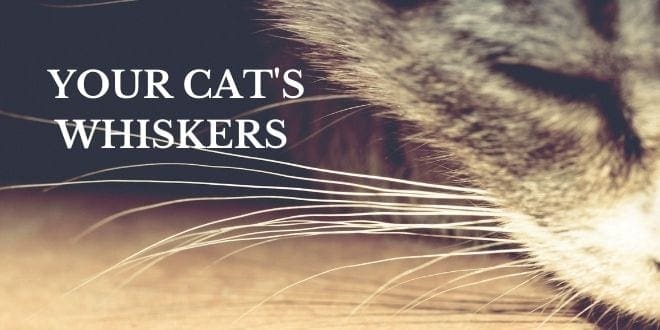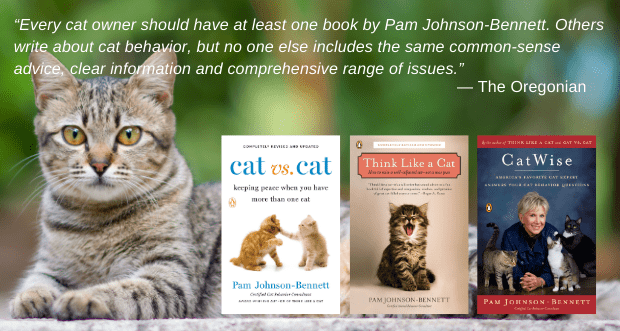
A cat’s whiskers… what do they do besides tickle our faces in the middle of the night?
Known also as vibrissae or tactile hairs, the whiskers serve several functions and are highly sensitive. Thicker than the cat’s normal hair, the whiskers are really touch receptors that are rooted more deeply than normal hairs and are rich in nerve endings.
Muzzle whiskers on most cats, which are called mystacial whiskers, number 24 in total — 12 on each side, in four rows. The top two rows can move independently from the bottom two rows. Mystacial whiskers help with accurate navigation of the cat’s environment.
In addition to mystacial whiskers, cats have whiskers above the eyes, on the chin, near the ears, and carpal whiskers on the underside of the wrists.
Whisker Navigation
The whiskers are so sensitive they can aid cats in detecting vibrations in the air and changes in air currents. This ability helps cats navigate in a dark environment. Cats use whiskers in the dark in the same way you would hold out your arms so your fingers could feel for objects. By determining changes in air currents, cats can avoid walking into an object. This ability to detect air currents also helps when hunting because cats can detect the potential swift movement of prey.
Propriocepters, which are sensory organs, are located at the end of the whiskers. Propriocepters relay information to the brain about the position of the body. This is one aid in how cats frequently are able to land on their feet.
A Tight Squeeze or a Perfect Fit for Your Cat?
The mystacial whiskers also help cats determine whether they can fit through a small opening. Theoretically, mystacial whiskers are about the same as the cat’s body width so if they can fit through an opening without bending, then the cat should be able to squeeze through. When cats poke their head into an opening, they are not only looking around in there, they’re doing a whisker measurement check to see if they can fit. Unfortunately, if the cat is overweight that whisker function isn’t always accurate.
A Cat’s Eye Protection
The whiskers above the eyes help when the cat is hunting in grass or bushy areas. They trigger a protective eye blink if there’s a branch or some brush that might get into the cat’s eyes. The whiskers also help during contact with other animals (including us) and if touched, they cause an eye blink.
Hunting Help for Cats
The carpal whiskers, located on the underside of the cat’s wrist are very useful in hunting. When the cat has prey captured in their paws, the carpal whiskers help determine if there’s any movement. Since cats can’t see as well up close, the carpal whiskers also help determine the position of the prey to help in delivering an accurate killing bite. Carpal whiskers are also helpful to cats when climbing trees.
Whisker Sensitivity
The whiskers are so valuable that if cut or chewed off, they can inhibit hunting ability and even the cat’s ability to navigate around the environment. Cats may become fearful and disoriented.
Feline Mood Indicator
The cat’s whiskers can also reflect their mood. When the whiskers are hanging loosely on either side, a cat is probably relaxed. When getting ready for battle or is frightened, the whiskers are flattened against the face to prevent damage to them. When on the alert or hunting, the whiskers are forward-facing to aid in prey detection. If the cat has forward-facing whiskers but the ears are pinned back, it likely indicates aggression. Keep in mind though that you shouldn’t gauge your cat’s mood by just one thing. Take other body language signals into consideration along with the immediate environment.
Never Cut the Whiskers
Cutting the whiskers is extremely cruel and cause pain due to their sensitivity.
Whisker shedding does occur and is normal. You may notice the occasional whisker on the floor now and then so don’t be alarmed because they do grow back. While shedding is normal, if you notice an increase in the number of whiskers falling out, it could indicate an underlying medical condition so contact your veterinarian.
Do Cats Experience Whisker Stress?
Experts opinions differ as to whether there is such a thing as whisker stress or whisker fatigue. Whisker stress is based on the constant over-stimulation of the tip of whiskers being touched, either by getting bent or squished to reach the food or water in deep bowls. Most cat food bowls are shallow for this reason. If food or water bowls are too deep or narrow, cats may resort to dipping their paws in the bowl.
Whisker Color can Change with Age
As cats age, you may notice darker whiskers turning lighter, and white whiskers may turn more gray.
Need More Information?
For more information about cat behavior and training, refer to Pam’s books. Her books are available at bookstores and online. We’ve included links to Amazon here on our website.
If you have a question about your cat’s health, contact your veterinarian. This article is not intended as a medical diagnosis nor is it a replacement for your cat’s regular veterinary care. This article is for general information purposes only.





